Analysis of Organizational Failure: ADFA Sexual Harassment Report
VerifiedAdded on 2021/09/13
|15
|3557
|43
Report
AI Summary
This report provides an in-depth analysis of the organizational failure at the Australian Defense Force Academy (ADFA) concerning the sexual harassment of women. It meticulously examines the individual, group, and organizational factors that contributed to this failure, including excessive alcohol consumption, abuse of power, a male-dominated environment, and inadequate reporting mechanisms. The report identifies key stakeholders and their interests, detailing the impact of the abuse on victims and the academy as a whole. Furthermore, it assesses the post-failure responses, such as changes to the leadership team and security measures, evaluating their effectiveness and offering recommendations for future improvements. The analysis emphasizes the need for changes in perspective, psychological evaluations, and the eradication of alcohol consumption to drastically reduce abuse cases.

1
Course Title:
Australian Defense Force Academy (Sexual Harassment of Women)
Date:
Name:
Word Count:
Course Title:
Australian Defense Force Academy (Sexual Harassment of Women)
Date:
Name:
Word Count:
Paraphrase This Document
Need a fresh take? Get an instant paraphrase of this document with our AI Paraphraser
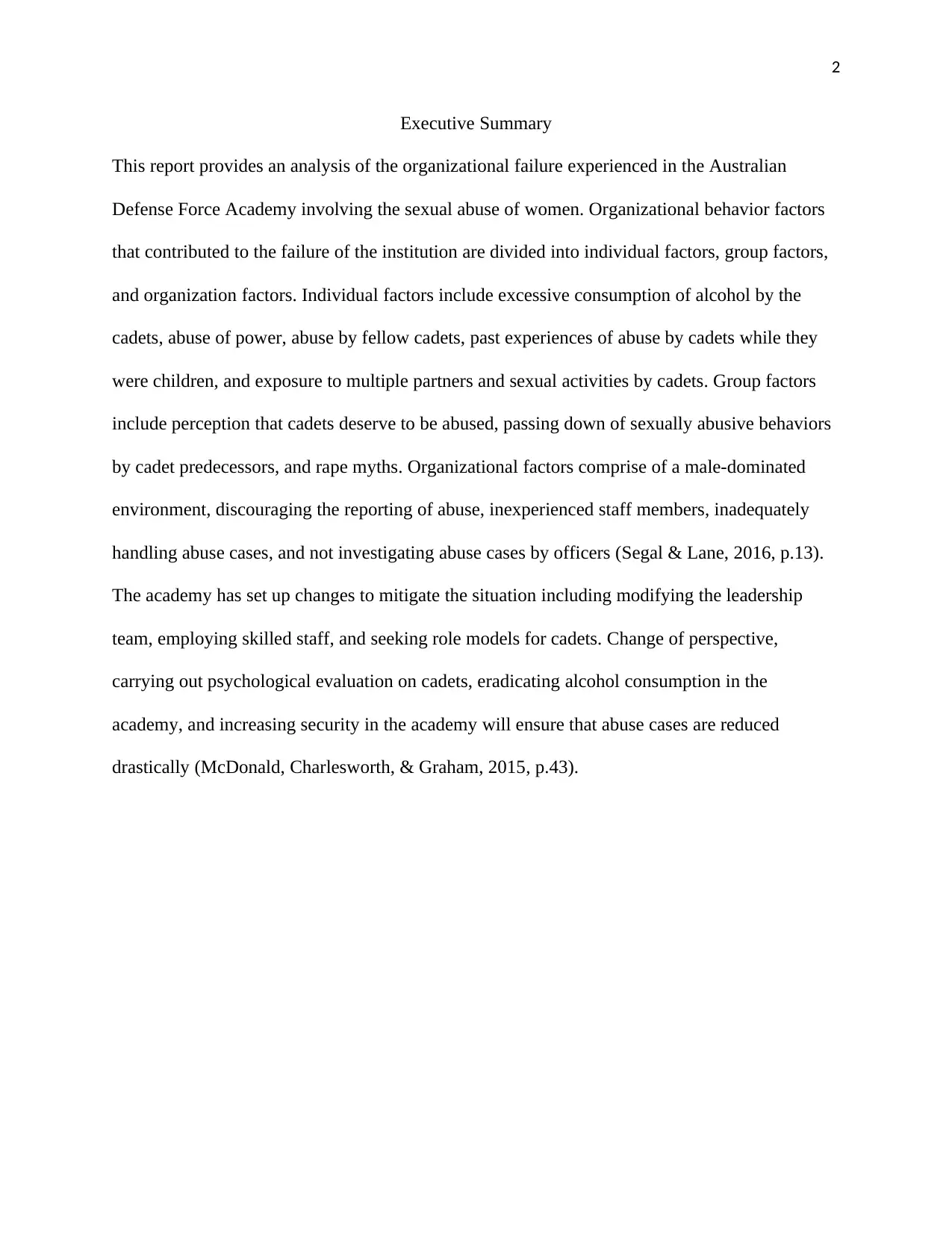
2
Executive Summary
This report provides an analysis of the organizational failure experienced in the Australian
Defense Force Academy involving the sexual abuse of women. Organizational behavior factors
that contributed to the failure of the institution are divided into individual factors, group factors,
and organization factors. Individual factors include excessive consumption of alcohol by the
cadets, abuse of power, abuse by fellow cadets, past experiences of abuse by cadets while they
were children, and exposure to multiple partners and sexual activities by cadets. Group factors
include perception that cadets deserve to be abused, passing down of sexually abusive behaviors
by cadet predecessors, and rape myths. Organizational factors comprise of a male-dominated
environment, discouraging the reporting of abuse, inexperienced staff members, inadequately
handling abuse cases, and not investigating abuse cases by officers (Segal & Lane, 2016, p.13).
The academy has set up changes to mitigate the situation including modifying the leadership
team, employing skilled staff, and seeking role models for cadets. Change of perspective,
carrying out psychological evaluation on cadets, eradicating alcohol consumption in the
academy, and increasing security in the academy will ensure that abuse cases are reduced
drastically (McDonald, Charlesworth, & Graham, 2015, p.43).
Executive Summary
This report provides an analysis of the organizational failure experienced in the Australian
Defense Force Academy involving the sexual abuse of women. Organizational behavior factors
that contributed to the failure of the institution are divided into individual factors, group factors,
and organization factors. Individual factors include excessive consumption of alcohol by the
cadets, abuse of power, abuse by fellow cadets, past experiences of abuse by cadets while they
were children, and exposure to multiple partners and sexual activities by cadets. Group factors
include perception that cadets deserve to be abused, passing down of sexually abusive behaviors
by cadet predecessors, and rape myths. Organizational factors comprise of a male-dominated
environment, discouraging the reporting of abuse, inexperienced staff members, inadequately
handling abuse cases, and not investigating abuse cases by officers (Segal & Lane, 2016, p.13).
The academy has set up changes to mitigate the situation including modifying the leadership
team, employing skilled staff, and seeking role models for cadets. Change of perspective,
carrying out psychological evaluation on cadets, eradicating alcohol consumption in the
academy, and increasing security in the academy will ensure that abuse cases are reduced
drastically (McDonald, Charlesworth, & Graham, 2015, p.43).
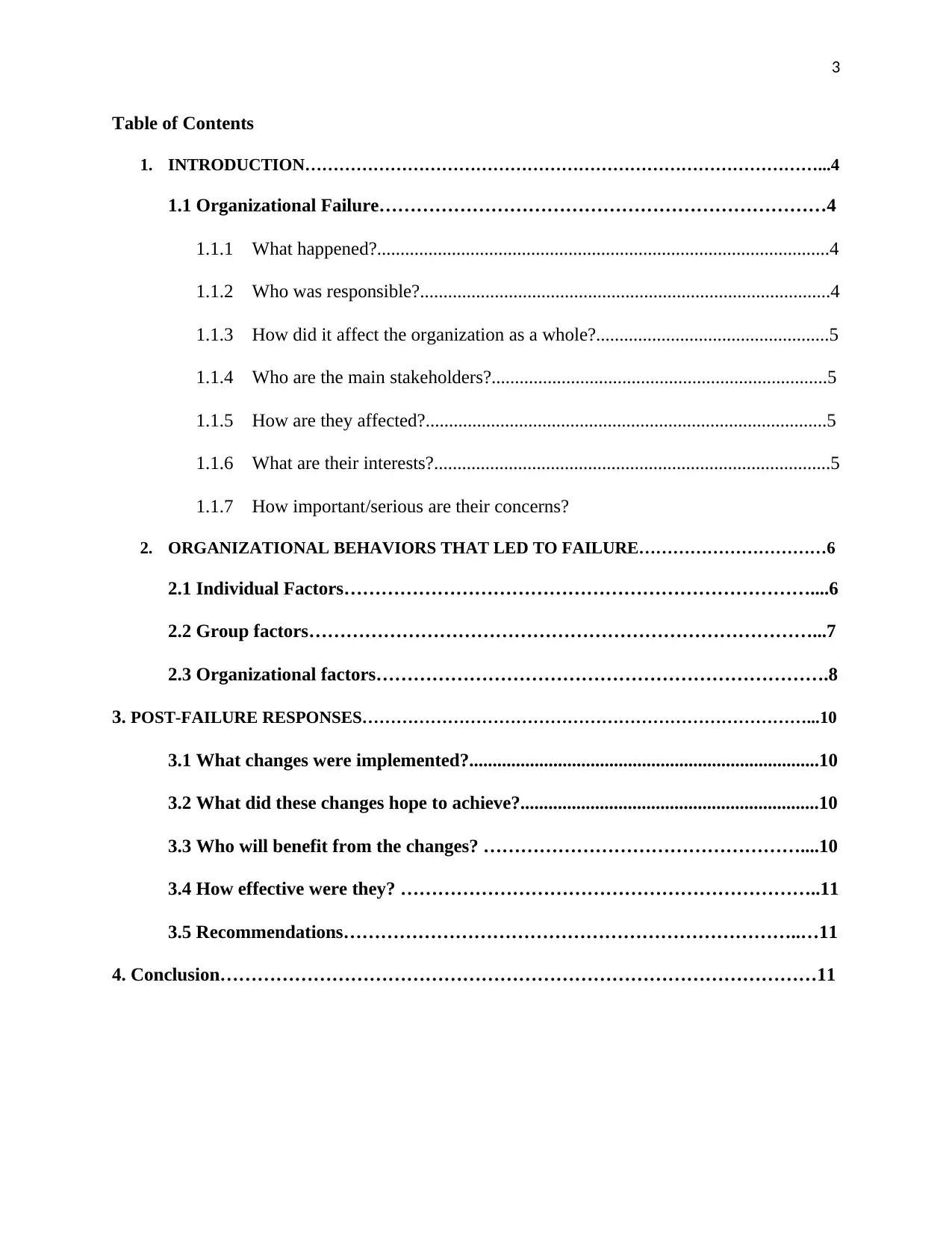
3
Table of Contents
1. INTRODUCTION………………………………………………………………………………...4
1.1 Organizational Failure………………………………………………………………4
1.1.1 What happened?.................................................................................................4
1.1.2 Who was responsible?........................................................................................4
1.1.3 How did it affect the organization as a whole?..................................................5
1.1.4 Who are the main stakeholders?........................................................................5
1.1.5 How are they affected?......................................................................................5
1.1.6 What are their interests?.....................................................................................5
1.1.7 How important/serious are their concerns?
2. ORGANIZATIONAL BEHAVIORS THAT LED TO FAILURE……………………………6
2.1 Individual Factors…………………………………………………………………....6
2.2 Group factors………………………………………………………………………...7
2.3 Organizational factors……………………………………………………………….8
3. POST-FAILURE RESPONSES……………………………………………………………………...10
3.1 What changes were implemented?...........................................................................10
3.2 What did these changes hope to achieve?................................................................10
3.3 Who will benefit from the changes? ……………………………………………....10
3.4 How effective were they? …………………………………………………………..11
3.5 Recommendations………………………………………………………………..…11
4. Conclusion……………………………………………………………………………………11
Table of Contents
1. INTRODUCTION………………………………………………………………………………...4
1.1 Organizational Failure………………………………………………………………4
1.1.1 What happened?.................................................................................................4
1.1.2 Who was responsible?........................................................................................4
1.1.3 How did it affect the organization as a whole?..................................................5
1.1.4 Who are the main stakeholders?........................................................................5
1.1.5 How are they affected?......................................................................................5
1.1.6 What are their interests?.....................................................................................5
1.1.7 How important/serious are their concerns?
2. ORGANIZATIONAL BEHAVIORS THAT LED TO FAILURE……………………………6
2.1 Individual Factors…………………………………………………………………....6
2.2 Group factors………………………………………………………………………...7
2.3 Organizational factors……………………………………………………………….8
3. POST-FAILURE RESPONSES……………………………………………………………………...10
3.1 What changes were implemented?...........................................................................10
3.2 What did these changes hope to achieve?................................................................10
3.3 Who will benefit from the changes? ……………………………………………....10
3.4 How effective were they? …………………………………………………………..11
3.5 Recommendations………………………………………………………………..…11
4. Conclusion……………………………………………………………………………………11
⊘ This is a preview!⊘
Do you want full access?
Subscribe today to unlock all pages.

Trusted by 1+ million students worldwide
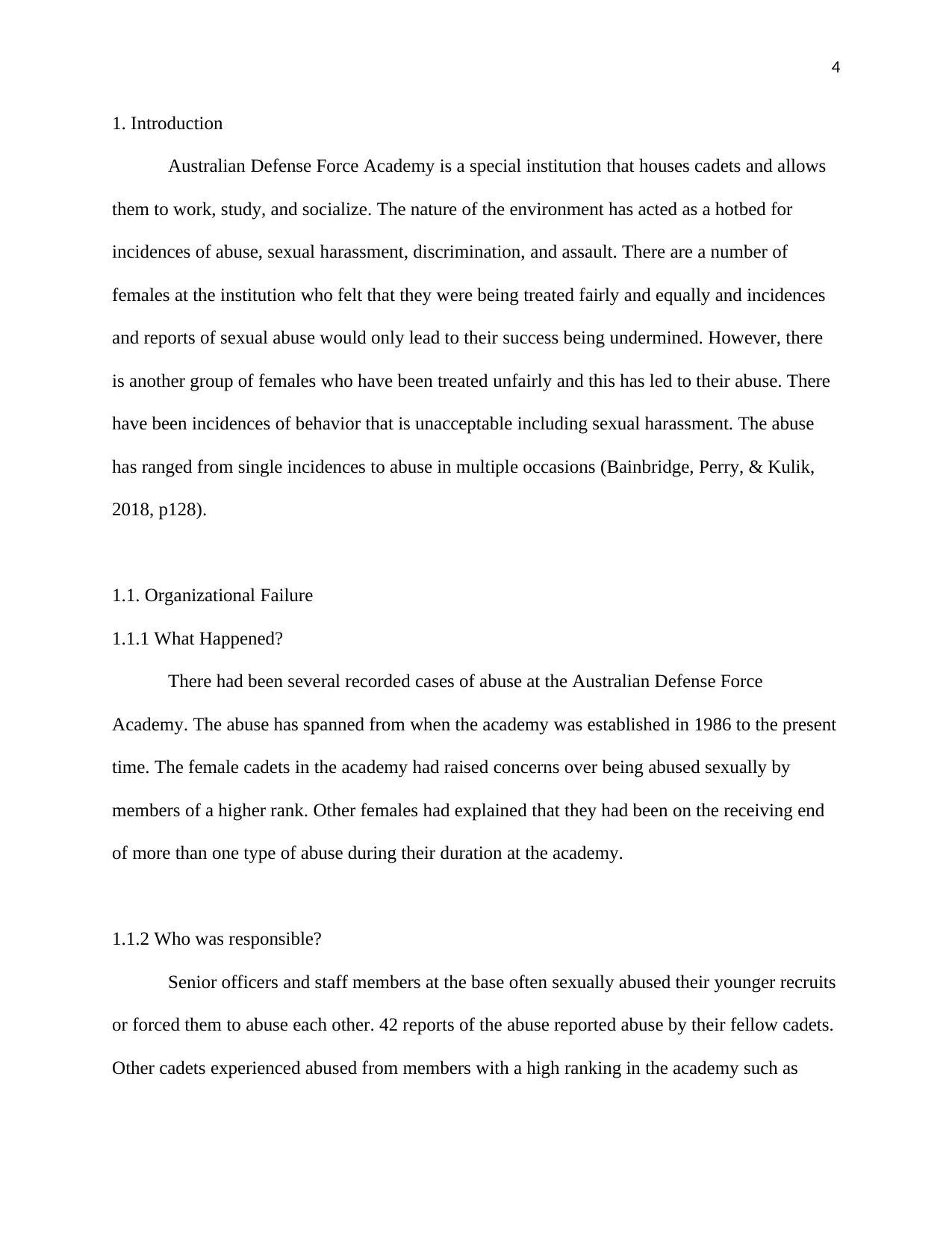
4
1. Introduction
Australian Defense Force Academy is a special institution that houses cadets and allows
them to work, study, and socialize. The nature of the environment has acted as a hotbed for
incidences of abuse, sexual harassment, discrimination, and assault. There are a number of
females at the institution who felt that they were being treated fairly and equally and incidences
and reports of sexual abuse would only lead to their success being undermined. However, there
is another group of females who have been treated unfairly and this has led to their abuse. There
have been incidences of behavior that is unacceptable including sexual harassment. The abuse
has ranged from single incidences to abuse in multiple occasions (Bainbridge, Perry, & Kulik,
2018, p128).
1.1. Organizational Failure
1.1.1 What Happened?
There had been several recorded cases of abuse at the Australian Defense Force
Academy. The abuse has spanned from when the academy was established in 1986 to the present
time. The female cadets in the academy had raised concerns over being abused sexually by
members of a higher rank. Other females had explained that they had been on the receiving end
of more than one type of abuse during their duration at the academy.
1.1.2 Who was responsible?
Senior officers and staff members at the base often sexually abused their younger recruits
or forced them to abuse each other. 42 reports of the abuse reported abuse by their fellow cadets.
Other cadets experienced abused from members with a high ranking in the academy such as
1. Introduction
Australian Defense Force Academy is a special institution that houses cadets and allows
them to work, study, and socialize. The nature of the environment has acted as a hotbed for
incidences of abuse, sexual harassment, discrimination, and assault. There are a number of
females at the institution who felt that they were being treated fairly and equally and incidences
and reports of sexual abuse would only lead to their success being undermined. However, there
is another group of females who have been treated unfairly and this has led to their abuse. There
have been incidences of behavior that is unacceptable including sexual harassment. The abuse
has ranged from single incidences to abuse in multiple occasions (Bainbridge, Perry, & Kulik,
2018, p128).
1.1. Organizational Failure
1.1.1 What Happened?
There had been several recorded cases of abuse at the Australian Defense Force
Academy. The abuse has spanned from when the academy was established in 1986 to the present
time. The female cadets in the academy had raised concerns over being abused sexually by
members of a higher rank. Other females had explained that they had been on the receiving end
of more than one type of abuse during their duration at the academy.
1.1.2 Who was responsible?
Senior officers and staff members at the base often sexually abused their younger recruits
or forced them to abuse each other. 42 reports of the abuse reported abuse by their fellow cadets.
Other cadets experienced abused from members with a high ranking in the academy such as
Paraphrase This Document
Need a fresh take? Get an instant paraphrase of this document with our AI Paraphraser
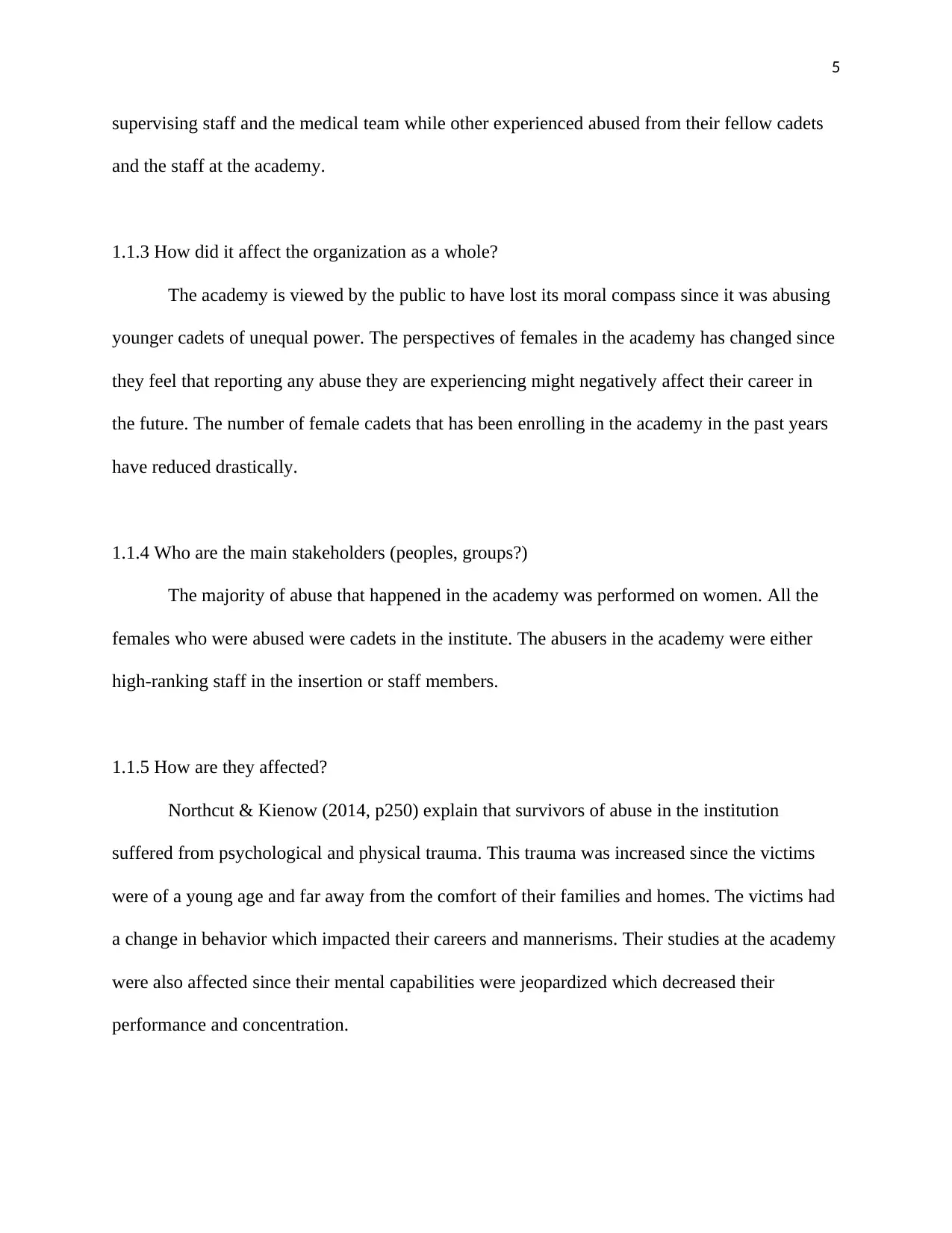
5
supervising staff and the medical team while other experienced abused from their fellow cadets
and the staff at the academy.
1.1.3 How did it affect the organization as a whole?
The academy is viewed by the public to have lost its moral compass since it was abusing
younger cadets of unequal power. The perspectives of females in the academy has changed since
they feel that reporting any abuse they are experiencing might negatively affect their career in
the future. The number of female cadets that has been enrolling in the academy in the past years
have reduced drastically.
1.1.4 Who are the main stakeholders (peoples, groups?)
The majority of abuse that happened in the academy was performed on women. All the
females who were abused were cadets in the institute. The abusers in the academy were either
high-ranking staff in the insertion or staff members.
1.1.5 How are they affected?
Northcut & Kienow (2014, p250) explain that survivors of abuse in the institution
suffered from psychological and physical trauma. This trauma was increased since the victims
were of a young age and far away from the comfort of their families and homes. The victims had
a change in behavior which impacted their careers and mannerisms. Their studies at the academy
were also affected since their mental capabilities were jeopardized which decreased their
performance and concentration.
supervising staff and the medical team while other experienced abused from their fellow cadets
and the staff at the academy.
1.1.3 How did it affect the organization as a whole?
The academy is viewed by the public to have lost its moral compass since it was abusing
younger cadets of unequal power. The perspectives of females in the academy has changed since
they feel that reporting any abuse they are experiencing might negatively affect their career in
the future. The number of female cadets that has been enrolling in the academy in the past years
have reduced drastically.
1.1.4 Who are the main stakeholders (peoples, groups?)
The majority of abuse that happened in the academy was performed on women. All the
females who were abused were cadets in the institute. The abusers in the academy were either
high-ranking staff in the insertion or staff members.
1.1.5 How are they affected?
Northcut & Kienow (2014, p250) explain that survivors of abuse in the institution
suffered from psychological and physical trauma. This trauma was increased since the victims
were of a young age and far away from the comfort of their families and homes. The victims had
a change in behavior which impacted their careers and mannerisms. Their studies at the academy
were also affected since their mental capabilities were jeopardized which decreased their
performance and concentration.
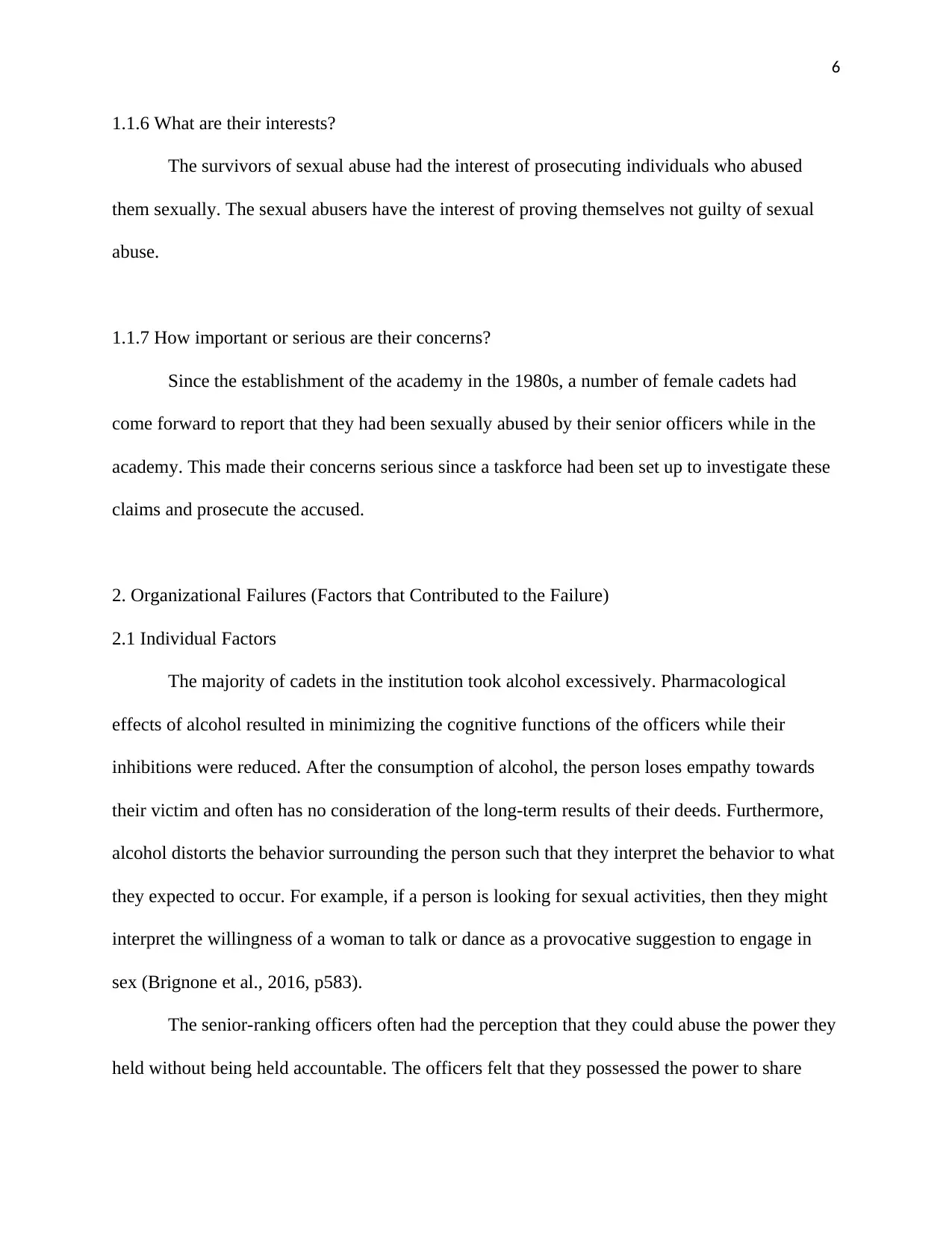
6
1.1.6 What are their interests?
The survivors of sexual abuse had the interest of prosecuting individuals who abused
them sexually. The sexual abusers have the interest of proving themselves not guilty of sexual
abuse.
1.1.7 How important or serious are their concerns?
Since the establishment of the academy in the 1980s, a number of female cadets had
come forward to report that they had been sexually abused by their senior officers while in the
academy. This made their concerns serious since a taskforce had been set up to investigate these
claims and prosecute the accused.
2. Organizational Failures (Factors that Contributed to the Failure)
2.1 Individual Factors
The majority of cadets in the institution took alcohol excessively. Pharmacological
effects of alcohol resulted in minimizing the cognitive functions of the officers while their
inhibitions were reduced. After the consumption of alcohol, the person loses empathy towards
their victim and often has no consideration of the long-term results of their deeds. Furthermore,
alcohol distorts the behavior surrounding the person such that they interpret the behavior to what
they expected to occur. For example, if a person is looking for sexual activities, then they might
interpret the willingness of a woman to talk or dance as a provocative suggestion to engage in
sex (Brignone et al., 2016, p583).
The senior-ranking officers often had the perception that they could abuse the power they
held without being held accountable. The officers felt that they possessed the power to share
1.1.6 What are their interests?
The survivors of sexual abuse had the interest of prosecuting individuals who abused
them sexually. The sexual abusers have the interest of proving themselves not guilty of sexual
abuse.
1.1.7 How important or serious are their concerns?
Since the establishment of the academy in the 1980s, a number of female cadets had
come forward to report that they had been sexually abused by their senior officers while in the
academy. This made their concerns serious since a taskforce had been set up to investigate these
claims and prosecute the accused.
2. Organizational Failures (Factors that Contributed to the Failure)
2.1 Individual Factors
The majority of cadets in the institution took alcohol excessively. Pharmacological
effects of alcohol resulted in minimizing the cognitive functions of the officers while their
inhibitions were reduced. After the consumption of alcohol, the person loses empathy towards
their victim and often has no consideration of the long-term results of their deeds. Furthermore,
alcohol distorts the behavior surrounding the person such that they interpret the behavior to what
they expected to occur. For example, if a person is looking for sexual activities, then they might
interpret the willingness of a woman to talk or dance as a provocative suggestion to engage in
sex (Brignone et al., 2016, p583).
The senior-ranking officers often had the perception that they could abuse the power they
held without being held accountable. The officers felt that they possessed the power to share
⊘ This is a preview!⊘
Do you want full access?
Subscribe today to unlock all pages.

Trusted by 1+ million students worldwide
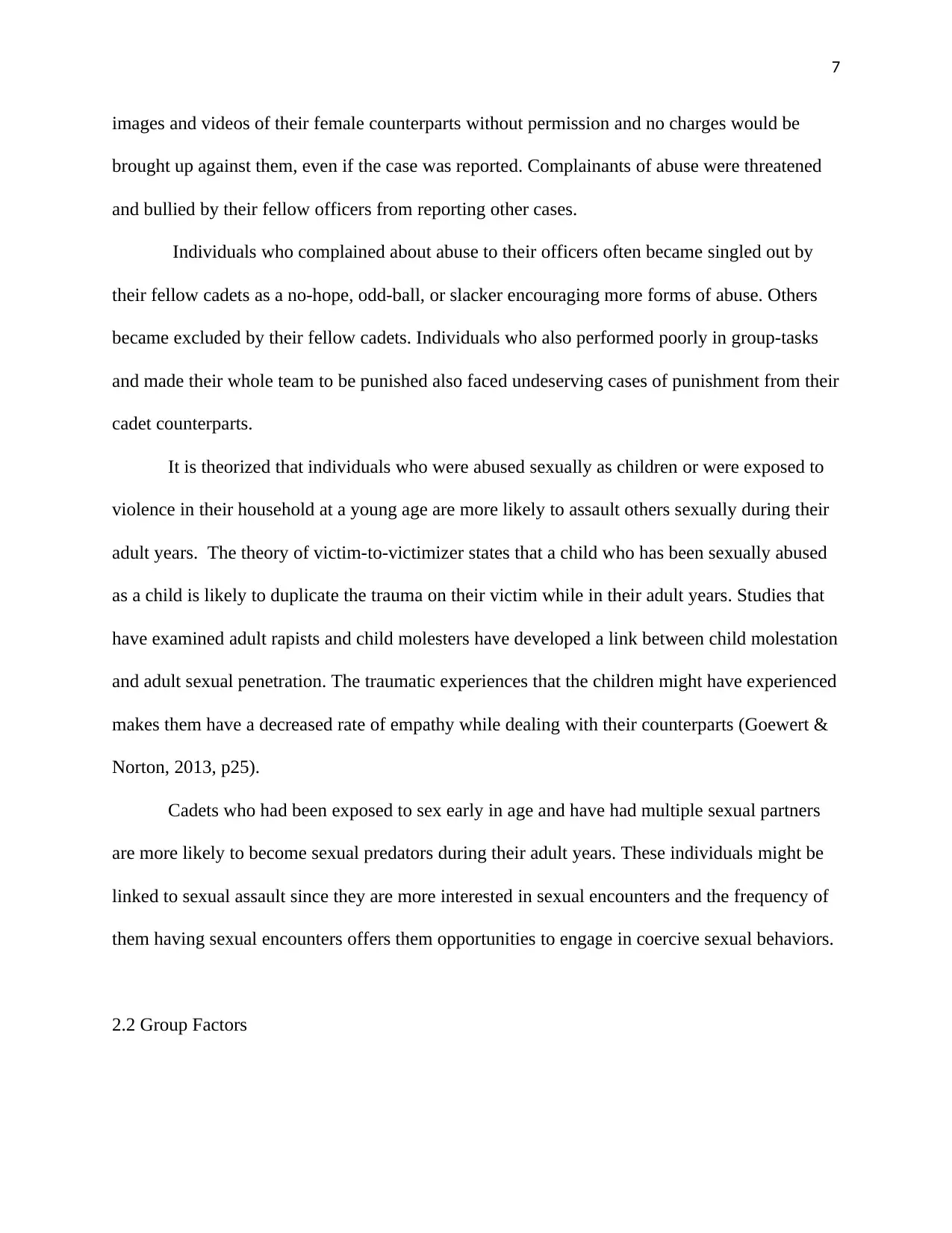
7
images and videos of their female counterparts without permission and no charges would be
brought up against them, even if the case was reported. Complainants of abuse were threatened
and bullied by their fellow officers from reporting other cases.
Individuals who complained about abuse to their officers often became singled out by
their fellow cadets as a no-hope, odd-ball, or slacker encouraging more forms of abuse. Others
became excluded by their fellow cadets. Individuals who also performed poorly in group-tasks
and made their whole team to be punished also faced undeserving cases of punishment from their
cadet counterparts.
It is theorized that individuals who were abused sexually as children or were exposed to
violence in their household at a young age are more likely to assault others sexually during their
adult years. The theory of victim-to-victimizer states that a child who has been sexually abused
as a child is likely to duplicate the trauma on their victim while in their adult years. Studies that
have examined adult rapists and child molesters have developed a link between child molestation
and adult sexual penetration. The traumatic experiences that the children might have experienced
makes them have a decreased rate of empathy while dealing with their counterparts (Goewert &
Norton, 2013, p25).
Cadets who had been exposed to sex early in age and have had multiple sexual partners
are more likely to become sexual predators during their adult years. These individuals might be
linked to sexual assault since they are more interested in sexual encounters and the frequency of
them having sexual encounters offers them opportunities to engage in coercive sexual behaviors.
2.2 Group Factors
images and videos of their female counterparts without permission and no charges would be
brought up against them, even if the case was reported. Complainants of abuse were threatened
and bullied by their fellow officers from reporting other cases.
Individuals who complained about abuse to their officers often became singled out by
their fellow cadets as a no-hope, odd-ball, or slacker encouraging more forms of abuse. Others
became excluded by their fellow cadets. Individuals who also performed poorly in group-tasks
and made their whole team to be punished also faced undeserving cases of punishment from their
cadet counterparts.
It is theorized that individuals who were abused sexually as children or were exposed to
violence in their household at a young age are more likely to assault others sexually during their
adult years. The theory of victim-to-victimizer states that a child who has been sexually abused
as a child is likely to duplicate the trauma on their victim while in their adult years. Studies that
have examined adult rapists and child molesters have developed a link between child molestation
and adult sexual penetration. The traumatic experiences that the children might have experienced
makes them have a decreased rate of empathy while dealing with their counterparts (Goewert &
Norton, 2013, p25).
Cadets who had been exposed to sex early in age and have had multiple sexual partners
are more likely to become sexual predators during their adult years. These individuals might be
linked to sexual assault since they are more interested in sexual encounters and the frequency of
them having sexual encounters offers them opportunities to engage in coercive sexual behaviors.
2.2 Group Factors
Paraphrase This Document
Need a fresh take? Get an instant paraphrase of this document with our AI Paraphraser
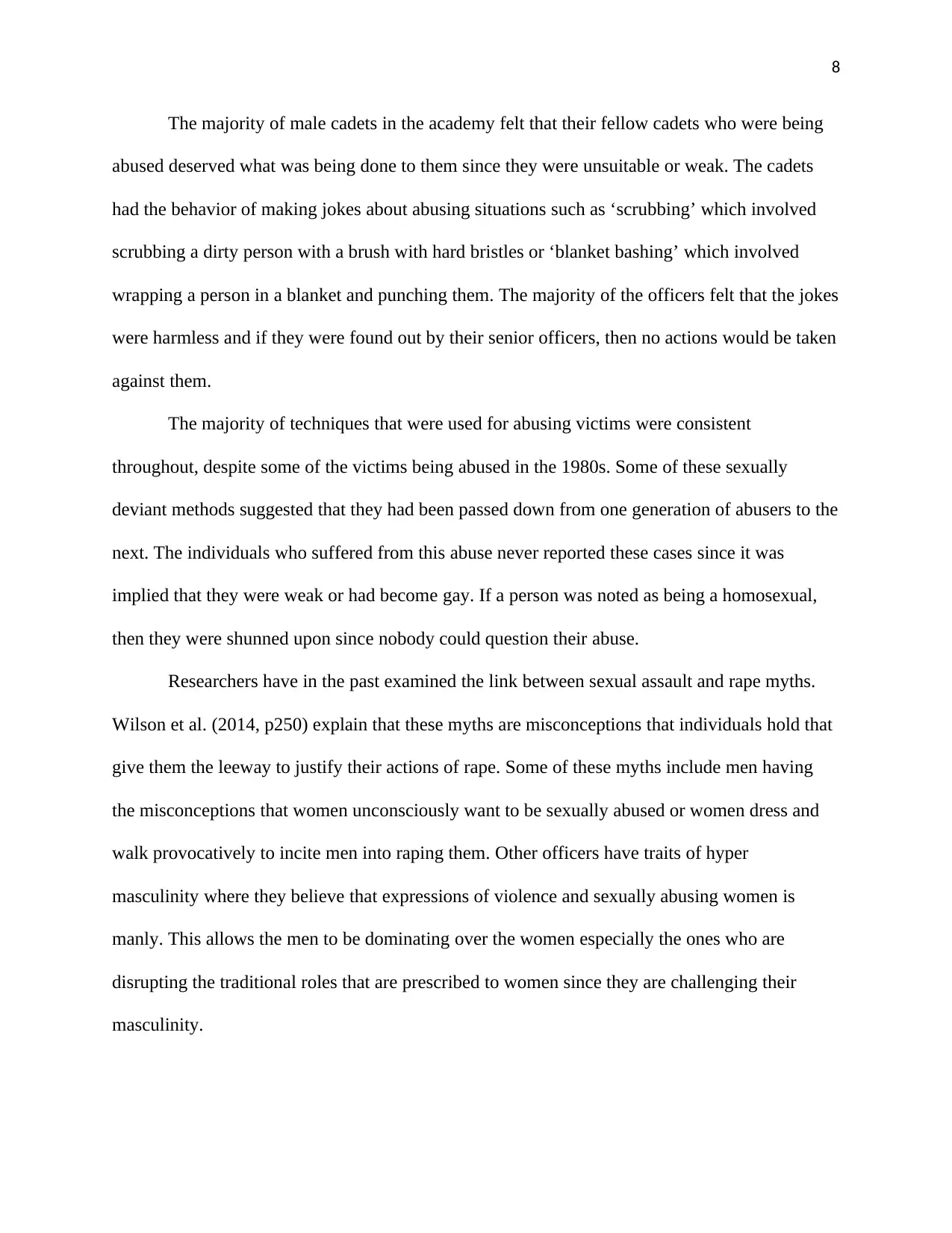
8
The majority of male cadets in the academy felt that their fellow cadets who were being
abused deserved what was being done to them since they were unsuitable or weak. The cadets
had the behavior of making jokes about abusing situations such as ‘scrubbing’ which involved
scrubbing a dirty person with a brush with hard bristles or ‘blanket bashing’ which involved
wrapping a person in a blanket and punching them. The majority of the officers felt that the jokes
were harmless and if they were found out by their senior officers, then no actions would be taken
against them.
The majority of techniques that were used for abusing victims were consistent
throughout, despite some of the victims being abused in the 1980s. Some of these sexually
deviant methods suggested that they had been passed down from one generation of abusers to the
next. The individuals who suffered from this abuse never reported these cases since it was
implied that they were weak or had become gay. If a person was noted as being a homosexual,
then they were shunned upon since nobody could question their abuse.
Researchers have in the past examined the link between sexual assault and rape myths.
Wilson et al. (2014, p250) explain that these myths are misconceptions that individuals hold that
give them the leeway to justify their actions of rape. Some of these myths include men having
the misconceptions that women unconsciously want to be sexually abused or women dress and
walk provocatively to incite men into raping them. Other officers have traits of hyper
masculinity where they believe that expressions of violence and sexually abusing women is
manly. This allows the men to be dominating over the women especially the ones who are
disrupting the traditional roles that are prescribed to women since they are challenging their
masculinity.
The majority of male cadets in the academy felt that their fellow cadets who were being
abused deserved what was being done to them since they were unsuitable or weak. The cadets
had the behavior of making jokes about abusing situations such as ‘scrubbing’ which involved
scrubbing a dirty person with a brush with hard bristles or ‘blanket bashing’ which involved
wrapping a person in a blanket and punching them. The majority of the officers felt that the jokes
were harmless and if they were found out by their senior officers, then no actions would be taken
against them.
The majority of techniques that were used for abusing victims were consistent
throughout, despite some of the victims being abused in the 1980s. Some of these sexually
deviant methods suggested that they had been passed down from one generation of abusers to the
next. The individuals who suffered from this abuse never reported these cases since it was
implied that they were weak or had become gay. If a person was noted as being a homosexual,
then they were shunned upon since nobody could question their abuse.
Researchers have in the past examined the link between sexual assault and rape myths.
Wilson et al. (2014, p250) explain that these myths are misconceptions that individuals hold that
give them the leeway to justify their actions of rape. Some of these myths include men having
the misconceptions that women unconsciously want to be sexually abused or women dress and
walk provocatively to incite men into raping them. Other officers have traits of hyper
masculinity where they believe that expressions of violence and sexually abusing women is
manly. This allows the men to be dominating over the women especially the ones who are
disrupting the traditional roles that are prescribed to women since they are challenging their
masculinity.
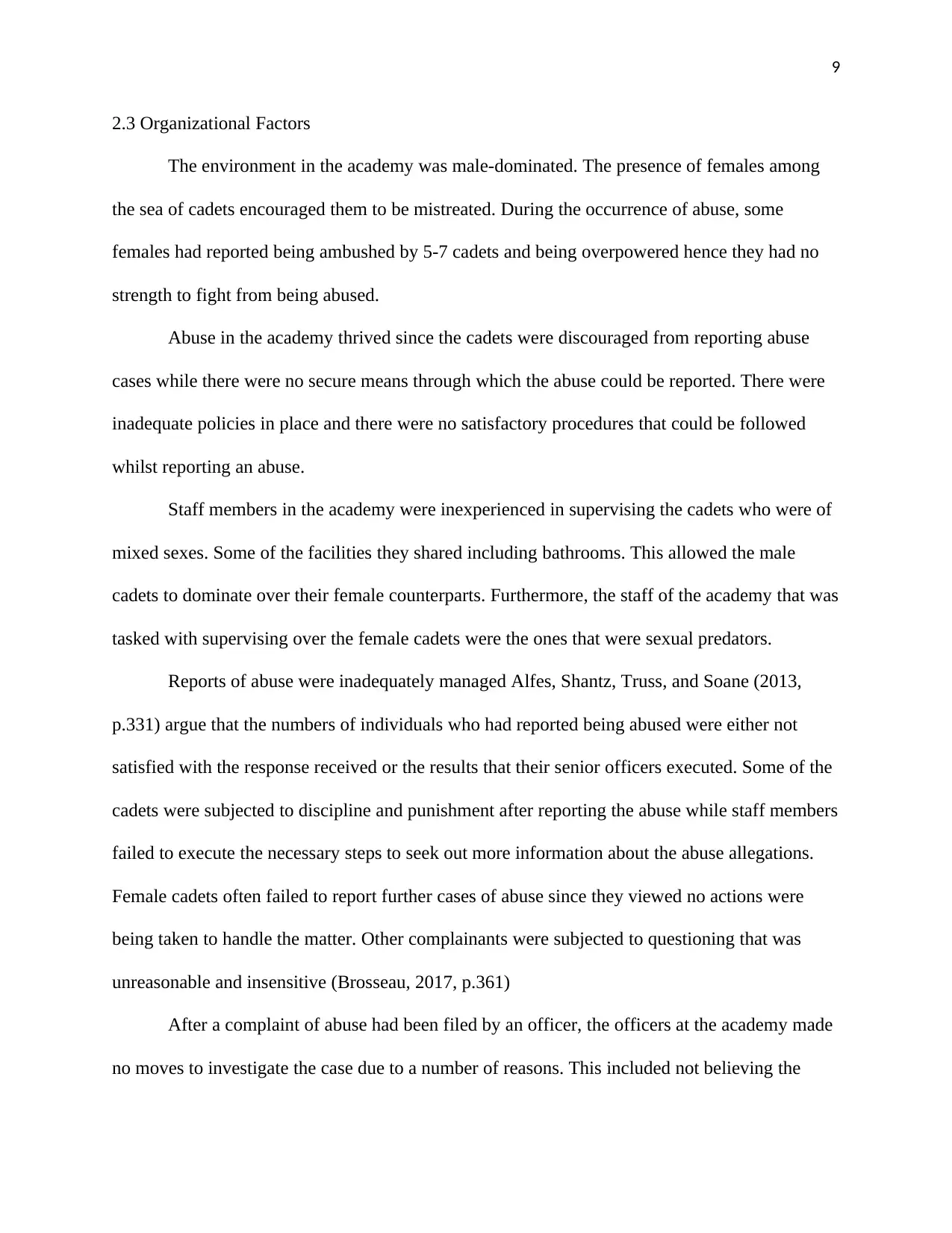
9
2.3 Organizational Factors
The environment in the academy was male-dominated. The presence of females among
the sea of cadets encouraged them to be mistreated. During the occurrence of abuse, some
females had reported being ambushed by 5-7 cadets and being overpowered hence they had no
strength to fight from being abused.
Abuse in the academy thrived since the cadets were discouraged from reporting abuse
cases while there were no secure means through which the abuse could be reported. There were
inadequate policies in place and there were no satisfactory procedures that could be followed
whilst reporting an abuse.
Staff members in the academy were inexperienced in supervising the cadets who were of
mixed sexes. Some of the facilities they shared including bathrooms. This allowed the male
cadets to dominate over their female counterparts. Furthermore, the staff of the academy that was
tasked with supervising over the female cadets were the ones that were sexual predators.
Reports of abuse were inadequately managed Alfes, Shantz, Truss, and Soane (2013,
p.331) argue that the numbers of individuals who had reported being abused were either not
satisfied with the response received or the results that their senior officers executed. Some of the
cadets were subjected to discipline and punishment after reporting the abuse while staff members
failed to execute the necessary steps to seek out more information about the abuse allegations.
Female cadets often failed to report further cases of abuse since they viewed no actions were
being taken to handle the matter. Other complainants were subjected to questioning that was
unreasonable and insensitive (Brosseau, 2017, p.361)
After a complaint of abuse had been filed by an officer, the officers at the academy made
no moves to investigate the case due to a number of reasons. This included not believing the
2.3 Organizational Factors
The environment in the academy was male-dominated. The presence of females among
the sea of cadets encouraged them to be mistreated. During the occurrence of abuse, some
females had reported being ambushed by 5-7 cadets and being overpowered hence they had no
strength to fight from being abused.
Abuse in the academy thrived since the cadets were discouraged from reporting abuse
cases while there were no secure means through which the abuse could be reported. There were
inadequate policies in place and there were no satisfactory procedures that could be followed
whilst reporting an abuse.
Staff members in the academy were inexperienced in supervising the cadets who were of
mixed sexes. Some of the facilities they shared including bathrooms. This allowed the male
cadets to dominate over their female counterparts. Furthermore, the staff of the academy that was
tasked with supervising over the female cadets were the ones that were sexual predators.
Reports of abuse were inadequately managed Alfes, Shantz, Truss, and Soane (2013,
p.331) argue that the numbers of individuals who had reported being abused were either not
satisfied with the response received or the results that their senior officers executed. Some of the
cadets were subjected to discipline and punishment after reporting the abuse while staff members
failed to execute the necessary steps to seek out more information about the abuse allegations.
Female cadets often failed to report further cases of abuse since they viewed no actions were
being taken to handle the matter. Other complainants were subjected to questioning that was
unreasonable and insensitive (Brosseau, 2017, p.361)
After a complaint of abuse had been filed by an officer, the officers at the academy made
no moves to investigate the case due to a number of reasons. This included not believing the
⊘ This is a preview!⊘
Do you want full access?
Subscribe today to unlock all pages.

Trusted by 1+ million students worldwide
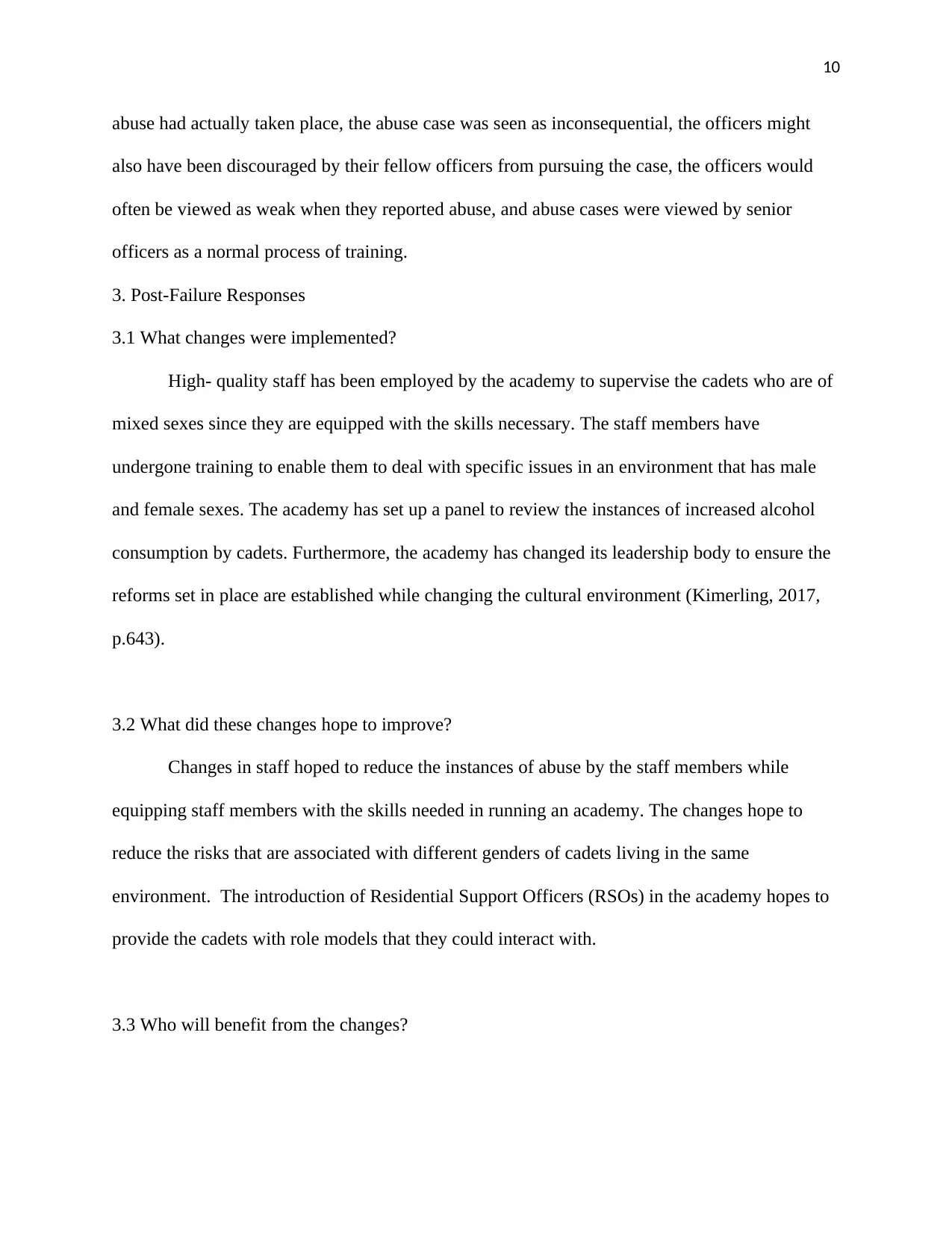
10
abuse had actually taken place, the abuse case was seen as inconsequential, the officers might
also have been discouraged by their fellow officers from pursuing the case, the officers would
often be viewed as weak when they reported abuse, and abuse cases were viewed by senior
officers as a normal process of training.
3. Post-Failure Responses
3.1 What changes were implemented?
High- quality staff has been employed by the academy to supervise the cadets who are of
mixed sexes since they are equipped with the skills necessary. The staff members have
undergone training to enable them to deal with specific issues in an environment that has male
and female sexes. The academy has set up a panel to review the instances of increased alcohol
consumption by cadets. Furthermore, the academy has changed its leadership body to ensure the
reforms set in place are established while changing the cultural environment (Kimerling, 2017,
p.643).
3.2 What did these changes hope to improve?
Changes in staff hoped to reduce the instances of abuse by the staff members while
equipping staff members with the skills needed in running an academy. The changes hope to
reduce the risks that are associated with different genders of cadets living in the same
environment. The introduction of Residential Support Officers (RSOs) in the academy hopes to
provide the cadets with role models that they could interact with.
3.3 Who will benefit from the changes?
abuse had actually taken place, the abuse case was seen as inconsequential, the officers might
also have been discouraged by their fellow officers from pursuing the case, the officers would
often be viewed as weak when they reported abuse, and abuse cases were viewed by senior
officers as a normal process of training.
3. Post-Failure Responses
3.1 What changes were implemented?
High- quality staff has been employed by the academy to supervise the cadets who are of
mixed sexes since they are equipped with the skills necessary. The staff members have
undergone training to enable them to deal with specific issues in an environment that has male
and female sexes. The academy has set up a panel to review the instances of increased alcohol
consumption by cadets. Furthermore, the academy has changed its leadership body to ensure the
reforms set in place are established while changing the cultural environment (Kimerling, 2017,
p.643).
3.2 What did these changes hope to improve?
Changes in staff hoped to reduce the instances of abuse by the staff members while
equipping staff members with the skills needed in running an academy. The changes hope to
reduce the risks that are associated with different genders of cadets living in the same
environment. The introduction of Residential Support Officers (RSOs) in the academy hopes to
provide the cadets with role models that they could interact with.
3.3 Who will benefit from the changes?
Paraphrase This Document
Need a fresh take? Get an instant paraphrase of this document with our AI Paraphraser

11
All the members of the academy will benefit from the implemented changes. This is
because both the male and female cadets would not have to live or study in fear of being sexually
abused by their peers or seniors. Staff members have gained skills that would ensure they fulfill
their responsibilities while making a human capital investment in their careers due to these skills
(Purce, 2014 p.69). The number of students enrolled in the academy is expected to increase since
there have been several changes implemented to deal with the issues that discouraged students
from enrolling.
3.4 How effective were they?
The changes implemented have become effective since they have allowed victims of
abuse to report instances of abuse. They are also effective since they cater to the needs and the
wishes of the abused victims. The institution has accepted that it has made mistakes in the past
that allowed some members to become abusers and others victims but has accepted its cause in
the matter and has set up policies and guidelines to rectify the situation (Hewitt, 2017, p.105).
3.5 Recommendations
There is a need to change the perspective of the academy to ensure that cadets report
abuse and that no negative consequences would befall them. There should be policies set in place
to ensure that academy discourages drinking of alcohol by the cadets as long as they are in the
environment of ADFA. This is because alcohol has been linked to the various negative behaviors
in the long-run. Security and safety in the academy should be increased to ensure that
unacceptable behavior is discouraged. There should be a mandatory psychological evaluation for
All the members of the academy will benefit from the implemented changes. This is
because both the male and female cadets would not have to live or study in fear of being sexually
abused by their peers or seniors. Staff members have gained skills that would ensure they fulfill
their responsibilities while making a human capital investment in their careers due to these skills
(Purce, 2014 p.69). The number of students enrolled in the academy is expected to increase since
there have been several changes implemented to deal with the issues that discouraged students
from enrolling.
3.4 How effective were they?
The changes implemented have become effective since they have allowed victims of
abuse to report instances of abuse. They are also effective since they cater to the needs and the
wishes of the abused victims. The institution has accepted that it has made mistakes in the past
that allowed some members to become abusers and others victims but has accepted its cause in
the matter and has set up policies and guidelines to rectify the situation (Hewitt, 2017, p.105).
3.5 Recommendations
There is a need to change the perspective of the academy to ensure that cadets report
abuse and that no negative consequences would befall them. There should be policies set in place
to ensure that academy discourages drinking of alcohol by the cadets as long as they are in the
environment of ADFA. This is because alcohol has been linked to the various negative behaviors
in the long-run. Security and safety in the academy should be increased to ensure that
unacceptable behavior is discouraged. There should be a mandatory psychological evaluation for
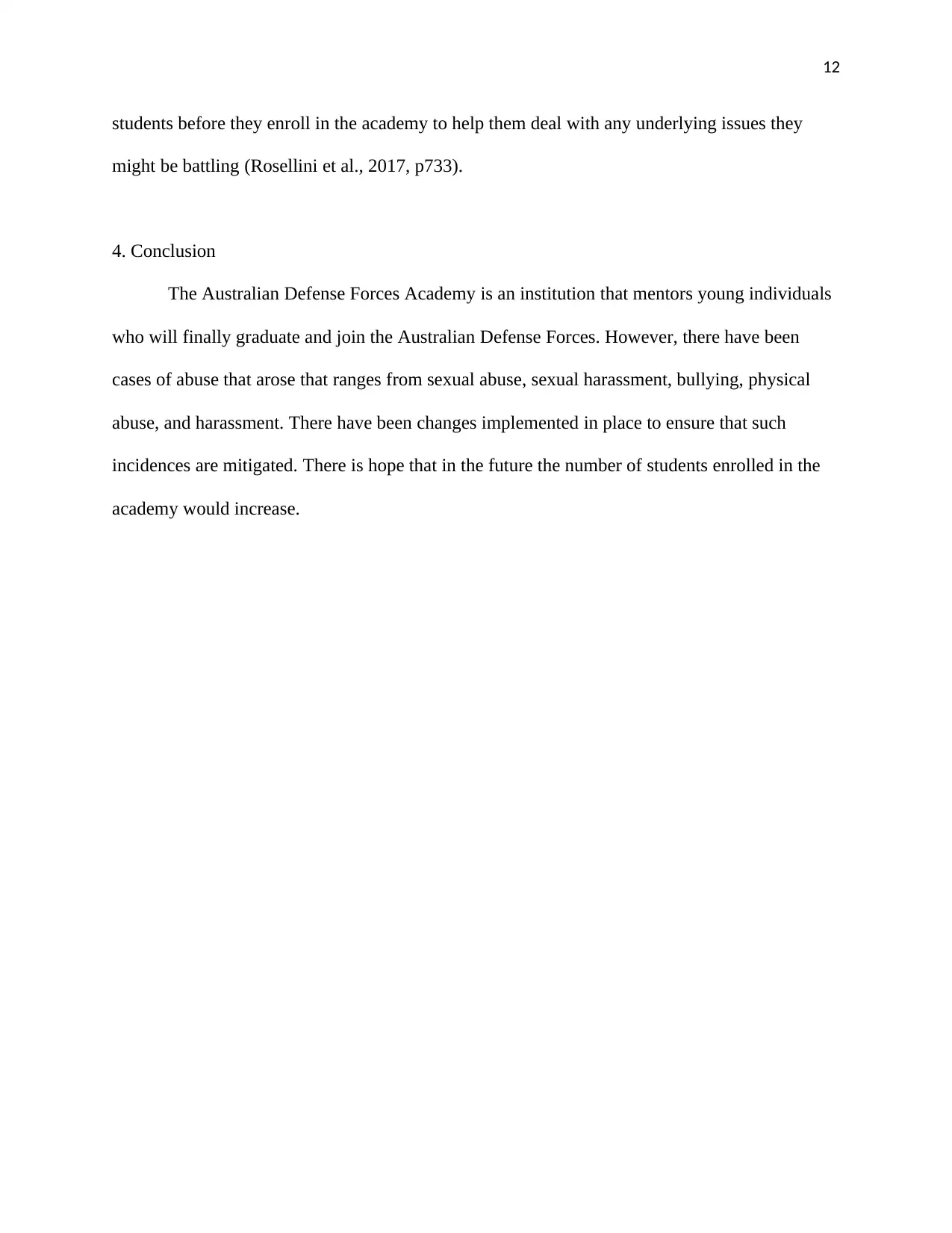
12
students before they enroll in the academy to help them deal with any underlying issues they
might be battling (Rosellini et al., 2017, p733).
4. Conclusion
The Australian Defense Forces Academy is an institution that mentors young individuals
who will finally graduate and join the Australian Defense Forces. However, there have been
cases of abuse that arose that ranges from sexual abuse, sexual harassment, bullying, physical
abuse, and harassment. There have been changes implemented in place to ensure that such
incidences are mitigated. There is hope that in the future the number of students enrolled in the
academy would increase.
students before they enroll in the academy to help them deal with any underlying issues they
might be battling (Rosellini et al., 2017, p733).
4. Conclusion
The Australian Defense Forces Academy is an institution that mentors young individuals
who will finally graduate and join the Australian Defense Forces. However, there have been
cases of abuse that arose that ranges from sexual abuse, sexual harassment, bullying, physical
abuse, and harassment. There have been changes implemented in place to ensure that such
incidences are mitigated. There is hope that in the future the number of students enrolled in the
academy would increase.
⊘ This is a preview!⊘
Do you want full access?
Subscribe today to unlock all pages.

Trusted by 1+ million students worldwide
1 out of 15
Related Documents
Your All-in-One AI-Powered Toolkit for Academic Success.
+13062052269
info@desklib.com
Available 24*7 on WhatsApp / Email
![[object Object]](/_next/static/media/star-bottom.7253800d.svg)
Unlock your academic potential
Copyright © 2020–2025 A2Z Services. All Rights Reserved. Developed and managed by ZUCOL.





